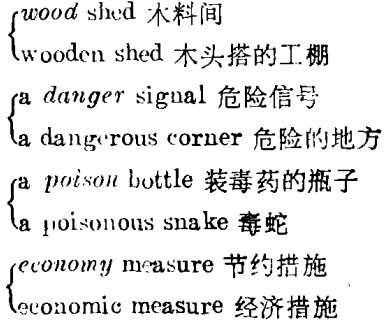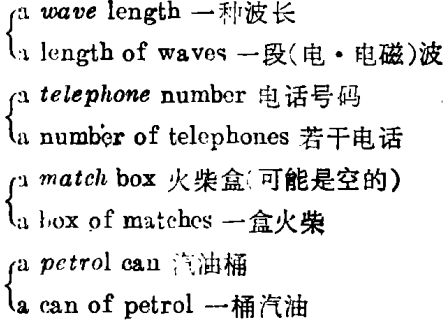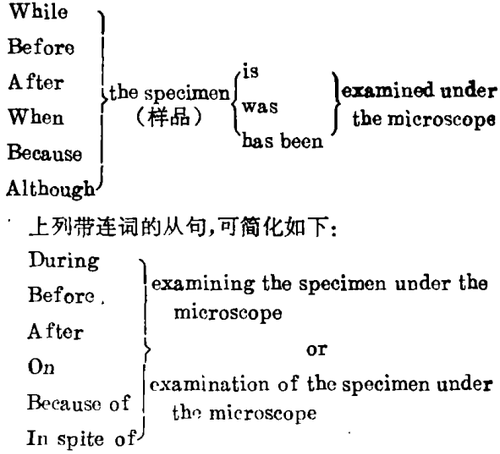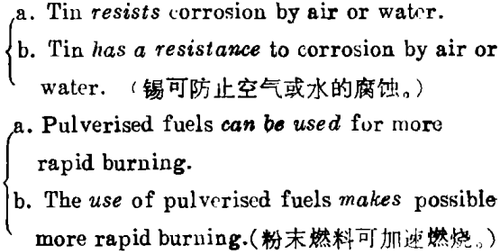当代美国翻译理论家奈达在《Grammar of Contemporary English》(p. 21)中说:“More complex grammatical correlates are to be found in the language of technical and scientific description: the passive is common and clause s are often ‘nominalized’”(在科技英语中,比较复杂的语法关系,表现在被动语态的普遍使用和从句的经常‘名词化’。)“名词化”(nominalization)的词主要指四种:即“动作名词”(action noun,如“examination”),“动词性名词”(verbal noun,如“the examining”),“动名词”(gerund,如“examining”),“不定式”(infinitive,如“to examine”),这四种都由动词派生;此外,还包括一些由形容词(加后缀-ity,-ness,-ability等)构成的名词。它们在句中起名词的作用,又可表达谓语动词或形容词所述内容,常常伴随修饰成分或附加成分。由“名词化”的词(作中心词)构成的短语叫名词化短语,又叫名词化结构。名词化短语的组合方式多,出现频率高,使用范围广,涵义容量大,适宜于表达精细复杂的内容,因此,名词化短语在科技英语中占优势,被认为科技文体中最显著、突出的特点之一。例如:
There is no pullution of the melted product. In vacuum induction furnaces in particular the cleanliness of the metal can be maintained by direct casting in the furnaces under the protective vacuum atmosphere. Distillation and recovery of distillates is also performed in the vacuum unit. 这种熔炼产品无污染。由于在炉内真空保护气氛下直接浇铸,真空感应炉尤能保持金属净度。蒸馏与蒸馏物的回收也在真空设备内完成。
上述小段共42个词,名词计16,约占38%余,频率很高。其中主要是半技术词(单个名词),其次是由半技术词复合而成的技术词(专用复合词)有:vacuum induction furnace,vacuum atmosphere;作前置定语的名词有:vacuum unit;名词化短语有:recovery of distillates,casting in the furnaces under the protective vacuum atmosphere. 这二个名词化短语的中心词分别为recovery、casting,它们各脱胎于同根动词recover、cast,保持动词(动作或状态)的内涵。此小段中名词化现象有:pollution(polute),distillation(distil),cleanliness(clean)。此外,在这严谨的科技英语中,为了避免重复,不用it,its,they,them,one等代词,而用替代名词(主要为术语),如用the furnaces来代替前面已出现过的vacuum induction furnaces。当代著名语言学家Simeon Potter在其《Changing English》一书中所谓“名词传染病”,即指名词和名词化短语的使用范围日益广泛,不仅“挤棹”了其他一些词类(如形容词),而且“顶替”了很多语法结构。虽然语言不是名词的罗列,但是科技英语中名词和名词化短语的顶替之广,是值得注意的主要特点之一。
一、顶替形容词或分词。例如:
Bridge crane桥式起重机(=a crane looking like a bridge)
Steam turbine汽轮机(=a turbine driven by steam)
Lead car领头车(=leading car)
Luxury hotel豪华旅馆(=luxurious hotel)
Affluence society富庶社会(=affluent society)
当然,这种顶替不是任何情况下都划等号的(如以atom bomb顶替atomic bomb)。名词作定语与同根形容词作定语有时意义不同。试比较:
二、顶替介词(或其他)短语。例如:
Cylinder head汽缸头(=head of a cylinder)
Water molecule水分子(=molecule of water)
Replacement part备用零件(=part for replacement)
Heat treatment热处理(=treatment with or by heat)
Workshop machinery车间机器(=machinery in a workshop)
但是,名词作定语与介词短语作定语有时意义有差别。如:
三、顶替分句或从句。例如:
manganese steel猛钢(=steel which contains manganese)
fire rescue火中救人(=rescue which is launched when fire breaks out)
奈达在《Grammar of Contemporary English》(p. 21)中列举了一个把句子转换为名词化的典型例子:
You can rectify the fault if you insert a wedge. 奈达认为,在科技文体中,上述两句宜转换为两个名词化短语,即用rectification of this fault和insertion of a wedge来顶替,全句应转换为:
Rectification of this fault is achieved by insertion of a wedge,如插入楔子,可矫正此误左。
四、从逻辑上看,名词化短语中的中心词与其定语的逻辑关系,主要有下列四种同形异构的顶替作用:
1. 顶替主谓结构(修饰成分是逻辑主语)
electron,drift电子漂移(=Electrons drift. )
the gas flow气流(=The gas flows. )
the rusting of iron生锈(=Iron rusts. )
2. 顶替动宾结构(修饰成分是逻辑宾语,中心词由及物动词派生)
Steel making炼钢(=make steel)
Weather observation观察气象(=observe weather)
Vibration isolation隔振(=isolate vibration)
3. 顶替谓状结构
laboratory test实验室测试(=test in laboratory)
air control空气控制,压气操纵(=control by air)
4. 顶替主谓宾或主谓(宾)状结构
(This accounts for)ice having a lower density than water. (由此说明)冰的密度比水小。(句中ice是having的逻辑主语。Ice having a lower density than water,相当于Ice has a lower density than water。)
名词化短语除直接充当句中的主语、宾语、表语外,其常用的语法结构还有下列三种。
一、用介词连接(作介词宾语)
However,in the presence of air,surface oxides may from within the engine. 然而,若有空气存在,发动机内可能形成表面氧化物。(用介词in连接名词化短语the presence of air,相当于if air is present。)
The method of transfer of metal to the work-piece depends on the magnitude of the current. 金属过渡到工件的方法,取决于电流大小。(用of连接的名词化短语transfer of metal to the work-piece,相当于(the method)by which metal is transferred to the work-piece。)
二、用中性动词(empty verb)过渡
这种过渡使行为动词名词化,即用无词义的中性动词(如make,take,give,get,do,have等)作谓语,动作名词则充当宾语,形成“中性动词十动作名词(+介词短语)”的结构。其中中性动词只有句法作用,其语义则由名词化短语来表示。例如:
Curved rails offer resistance to the movement of the train. 弯曲钢轨阻碍火车运用。(句中offer只是中性动词,不含词义,仅把主语部分和宾语部分连接起来,本句相当于:Curved rails resist the movement of the train。)
Breaking up the larger molecules of the heavier liquids in the petroleum mixture into the small- er, lighter molecules of gasoline is carried out in huge refinery tanks by certain materials called catalysts. 将石油混合物中较重液体的较大分子分解成较轻的汽油分子,此过程要在某些催化剂作用下、在巨大炼油罐中进行。(句中中性动词carryout与名词化短语连用,其含义量极微,与其说是语义的需要,不如说是句子结构的需要。这类中性动词尚有:present,obtain,achieve,perform,establish等。)
三、与动词构成固定搭配
其主要结构是:“动词(vt.)+名词化短语”;或“动词(vi.)+介词+名词化短语”。这种固定搭配数量丰富,约定俗成。举例如下:
bear(stand)comparison with同…相匹配
bear(a)relation to与…有关
call attention to(促)使注意
call into action开动,使用,实行
come in contact with同…接触
come into collision with和…相撞
come to perfection使完善
come to a decision作出决定
draw a distinction between在…和…间划界线
find application (use) in 用于
got in touch with 接触
got rid of (from)摆脱
give effect to 作用于
give credit to 相信
put --out of existence 灭绝
have consideration for 考虑(到)
have an attraction for 对…有吸引力
keep in touch with 接触
keep...under control 支配,控制
lay emphasis on 强调
make influence on 影响到
put (place) emphasis on (upon) 强调
stand in need of 需要
take possession of 占有
例句:Airplanes use radio to keep in touch with the ground.飞机利用无线电与地面保持联系。
In steel plants, cameras ate mounted to give a view of furnace flames.钢铁厂安装显示器,可用来——观察高炉内火焰。
When a force sets an object in. mot ion 9 the momentum of the object is changed. 当力使某物运动时,就改变其动向。
关于名词化短语的修辞特点有:一、简洁性;二、确切性;三、严密性;四、客观性。
一、简洁性 某些状语从句常常可简化成“介词+名词化短语”结构。例如:
名词化短语可用来表达一个句子的内容。例如下面两句:
1. The rocket has been developed。
2,For this reason,man can enter space。
可用两个名词化短语(the development of the rocket,for man to enter space)按句法联成一句:
The development of the rocket makes it possible for man to enter space. (句中make是中性动词,it是形式宾语,这两者无词义,而possible由情态动词can转换,有情态涵义,故make it possible承前启后,还隐穴逻辑因果,表达了for this reason的含义。类似can转换为possible的例子还有:may转换为possible;cannot转换为impossible;must转换为necessary或essential等,但均须用先行词it作形式宾语或形式主语。)
运用名词化短语,不仅可把二句合而为一,臻于简洁,而且可将更多信息溶于一体,表达更细密,使彼此逻辑联系更明确。如下列三句可分别转换为名词化短语:
1. NO2-N in water samples is determined. →determination of NO2-N in water samples 确定水样中NO2-N
2. A sulphonamide diazonium method is used. →using a sulphonamide diazonium method 利 用磺胺重氮法
3. NO2-N in water samples is reduced with zine powder. →seduction of NO2-N in water samples with zine powder用锌粉减少水样中NO2-N
再用介词by和after连接,用中性动词achieve过渡,按其内在逻辑联系合成一句:
Determination of NO2-N in water sample was achieved by using a sulphonamide diazonium method after reduction with zinc powder.
二、确切性 在四种名词化短语结构中,可以区分其名词性特征与动词性特征的程度差别。这一区分使科技文体表达更确切。试比较下列四句:
1. Recovery of distillates is also performed in the vacuum unit.
2. Recovering distillates is also performed in the vacuum unit.
3. The recovering of distillates is also performed in the vacuum unit.
4. The distillates need to be recovered now.
第1句用动作名词,表示一般事实与概念,指出动作和技术的特性,而不强调其动作本身的进行和时间;第2句用动名词,则强调动作与过程;第3句用动词性名词,其动作过程确有所指,故前面冠以定冠词the(定冠词是词类转化为名词的标志,其后面常连用介词短语,主要是of短语);第4句用由to加原型动词构成的不定式,表示某次有时间性的特定动作或过程。
三、严密性 名词化短语言简意赅,结构严密,从逻辑上看,除具备逻辑谓语外,还具备逻辑主语、逻辑表语、逻辑状语等作用。如:
Brief explanation of the principle简略说明此原理(逻辑状语)
=The principle is explained briefly。
Oxygen smelting of copper concentration铜浓度加氧熔炼(逻辑主语)
=Copper concentration is smelted with oxygen。
在科技英语句子中,信息较复杂、结构较严密的部分,要算扩大的名词化短语了。例如:
The rusting of iron is only one example of corrosion, which may be described as the destructive chemical attack of a metal by media with which it comes in contact, such as moisture, air and water.
上述扩大的名词化结构中,中心词attack有四个叠加修饰语,旁生枝节,层层包孕,徜若按传统语法仅把它们一一看成定语,就难以理解,无从下手。但如果从名词化结构的逻辑严密性入手分析,可以看出media是逻辑主语,metal是逻辑宾语,而destructive和chemical是两个副词性修饰语。这样条分缕析,全句可译成:“铁生锈仅是腐蚀的一个例子,腐蚀可解释为与金属接触的介质,如,湿气、空气和水对金属的破坏性化学侵蚀。”
四、客观性 描述的客观性是科技文体特征之一。名词化短语是文字表达客观性的重要手段之一,而被动语态也是提高客观度的主要途径。在科技英语中,这两者有时互为补充,配合使用。若同句出现,则相得益彰。例如:
The desorption of the residual gas from the coke is preferably carried out with the gas flow in the opposite direction to the flow direction during charging. 由于气体的流通方向与加料过程的流通方向相反,故焦炭的残余气体可以退吸。
值得注意的是:客观性还与中性动词密切存关。试比较:
比较之下,上列两个b句由于用了名词化结构,分别加上中性动词has,makes,就较为客观地反映了tin和pulverised fuels的自然特性。
下面谈谈名词化短语的三种译法,主要从其基本意义出发,联系上下文加以灵活处理。
一、译成状语(从句) 科技英语中常常用名词化短语作主语(部分)时,同其他部分之间可能存在一定的逻辑联系,如时间、原因、条件、目的、让步等。汉译时,可把这种名词化短语译成相应的状语(从句)。必要时,还可引申出某人或执行者充当行为主体,或译成汉语无主句。这种译法有时颇为奏效。例如:
Thus the decision to use a fixed wing was one that had to be made before any aeroplane could fly satisfactorily. 于是,人们不得不决定采用固定机翼,这样,飞机才能令人满意地飞行。
The application of electronic computers makes for a tremendous rise in labour productivity. 由于人们应用电子计算机,因此促使劳动生产率突飞猛进。
Even an elementary knowledge of statistics is sufficient to enable the journalist to avoid misleading his readers. 即使只懂得一点统计学的初步知识,也足以使记者避免报导失真。
The appropriate control of the amount of carbon and other alloying element攻 and various heat treatments may provide a wide range of physical properties in steel. 如果适当地调整碳与其他合金元素的含量,并施以不同的热处理,钢就会具有各种不同的物理性能。
二、译成分句或意合句 有些扩大的名词化结构枝杈伐生,叠加修饰,包孕多级短语或分句,但其逻辑联系并不十分严密,可把名词化结构看作独立的整体,按汉译化整为零法,把名词化短语拆开分译。例如:
A machine is a combination of resistant parts so arranged as to cause the force of nature to produce definite work with constrained. 机器是刚性部件的组合,其组合方式能使自然力按规定动作做一定的功。
Protection against complete structural failure is achieved in three different ways: first, by proper selection of material ,especially in high load areas, to provide a consistent slow rate of crack propagation, and high residual strength; second, by providing such multipath structure on the airplane that the loss of any one segment would not endanger the airplane;and third, by providing readily accessible structure which can beinspected and maintained properly. 可用三种方法防止整个结构损坏:一、适当选用材料,特别在高载荷区,要选用有一致性、迟缓裂痕扩散速率特性和高剩余强度的材料;二、选用多路传力结构,使某局部损坏不危及整个飞机;三、使结构具有易卸性,便于检查与维修。(原句中,除主语部分是一个名词化结构外,状语部分有三个名词化结构,用by引出,作in three different ways的同位语。这三个名词化结构中包孕介词短语、不定式短语和多级分句。虽头绪繁杂,扑朔迷离,但化繁为简,则似庖丁解牛。)
三、增加词量 有些名词化的词(不定式除外),加冠词后则含具体意义(如:institution建立→a institution机构,construction建筑→a construction建筑物,mixture混合→a mixture混合物,selection选择→a selection选集);有些名词化的词,其复数形式可转化为具体名词(如:connection连接→connections结合处,development发展→developments发展成果,instruction指示→instructions说明书,finding寻找→findings调查结果,observation观察→observations观察到的结果)。对此同形异义,汉译时需根据上下文增加一些适当的词,当然,这不是无中生有地随意加词,而是增加原文中虽无其形而有其意的一些词。略举数例:
They are well acquainted with the use of rifles. 他们熟知步枪的使用方法。
The letter dwelled on the evils and derangements prevalent in every department. 信件中详细叙述了各部门的弊端和紊乱现象。
After all preparations were made, the planes were flown across the U. S. to San Francisco. 一切准备工作就绪后,飞机就飞越美国内陆去旧金山。
Improvements here and there may in fact do more harm than good.东补西修的办法,事实上使事情可能有害无利。
练习:英译下列句子(试将汉语中的动词转译成英语名词化的词:make use of,improvement,construction,comparison,development,release,application,loss等。)
1. 我们可用激光(laser beams)在金刚石(diamond)上打孔。
2. 利用过热(superheated)蒸汽,可改进效率。
3. 这幢大楼正在建造中。
4. 我们把它们仔细比较一下,就发现不同处。
5. 火箭是新近发展起来的。
6. 水沸腾时,放出蒸汽。
7火箭已经用来探索(exploration)宇宙。
8. 锅炉(boiler)的热量没有损耗。
练习参考答案:
1. a) It is possible(for us) to make use of laser beams to burn a hole in. a diamond, (or b: A hole can be burnt in a diamond by using laser beams. or: c) Use can be made of laser beams to burn a hole in a diamond.) a句用先行词it作形式主语,并用与动词构成固定搭配的make use of,其中for us可用可不用,possible由can转换,着重其可能性。b句用被动语态,强调结果。c句也是被动语态,旨在impersonal. )
2. An improvement of performance can be achieved by the used of superheated steam.(用中性动词achieve过渡。)
3. The building is under construction.(用介词under连接,作表语,含被动意思)
4. From careful comparison we can readily see their difference.(用介词from连接,作状语。)
5. The rocket is something of recent development,(用介词of连接,作表语)
6. The boiling water causes the telease of steam. (用中性动词cause过渡)
7. Rockets have found application for the exploration of the universe.(用中 性动词 find 过渡)
8. There was no loss of heat in the boiler.(如译成:The heat in the boiler was not lost 不符合汉语所强调的“ 损耗” 所产生的结果。用“There be…”惯用句型,并把汉语的谓语动词“损耗”转换成作主语的动作名词loss,就较确切、客观。)(笔者注:这次练习改了样,不是说这“讲”形式比前几“讲”好,只是“横看成岭侧成峰”,参合两种形式有利于窥其全貌罢了。)



